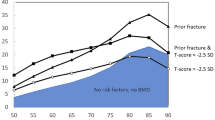Abstract:
Hip geometry and bone mineral density (BMD) have previously been shown to relate independently to hip fracture risk. Our objective was to determine by how much hip geometric data improved the identification of hip fracture. Lunar pencil beam scans of the proximal femur were obtained. Geometric and densitometric values from 800 female controls aged 60 years or more (from population samples which were participants in the European Prospective Osteoporosis Study, EPOS) were compared with data from 68 female hip fracture patients aged over 60 years who were scanned within 4 weeks of a contralateral hip fracture. We used Lunar DPX ‘beta’ versions of hip strength analysis (HSA) and hip axis length (HAL) applied to DPX(L) data. Compressive stress (Cstress), calculated by the HSA software to occur as a result of a typical fall on the greater trochanter, HAL, body mass index (BMI: weight/(height)2) and age were considered alongside femoral neck BMD (FN-BMD, g/cm2) as potential predictors of fracture. Logistic regression was used to generate predictors of fracture initially from FN-BMD. Next age, Cstress (as the most discriminating HSA-derived parameter), HAL and BMI were added to the model as potentially independent predictors. It was not necessary to include both HAL and Cstress in the logistic models, so the entire data set was examined without excluding the subjects missing HAL measurements. Cstress combined with age and BMI provided significantly better prediction of fracture than FN-BMD used alone as is current practice, judged by comparing areas under receiver operating characteristic (ROC) curves (p<0.001, deLong’s test). At a specificity of 80%, sensitivity in identification was improved from 66% to 81%. Identifying women at high risk of hip fracture is thus likely to be substantially enhanced by combining bone density with age, simple anthropometry and data on the structural geometry of the hip. HSA might prove to be a valuable enhancement of DXA densitometry in clinical practice and its use could justify a more pro-active approach to identifying women at high risk of hip fracture in the community.
Similar content being viewed by others
Author information
Authors and Affiliations
Additional information
Received: 16 March 2001 / Accepted: 3 August 2001
Rights and permissions
About this article
Cite this article
Crabtree, N., Kroger, H., Martin, A. et al. Improving Risk Assessment: Hip Geometry, Bone Mineral Distribution and Bone Strength in Hip Fracture Cases and Controls. The EPOS Study. Osteoporos Int 13, 48–54 (2002). https://doi.org/10.1007/s198-002-8337-y
Issue Date:
DOI: https://doi.org/10.1007/s198-002-8337-y




